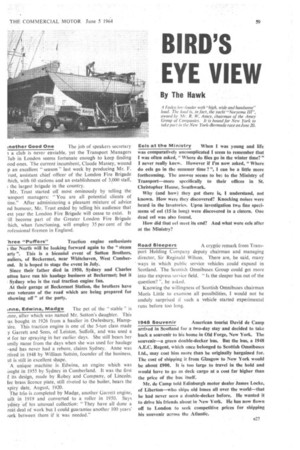BIRD'S EYE VIEW
Page 61

If you've noticed an error in this article please click here to report it so we can fix it.
By The Hawk
Lnother Good One The job of speakers secretary
a club is never enviable, yet the Transport Managers :lub in London seems fortunate enough to keep finding ood ones. The current incumbent, Claude Massey, wound p an excellent " season " last week by producing Mr. F. 'rust, assistant chief officer of the London Fire Brigade thich, with 60 stations and an establishment of 3,000 staff, ; the largest brigade in the country.
Mr. Trust started off most ominously, by telling the .ansport managers: "You are all potential clients of tine." After administering a pleasant mixture of advice nd humour, Mr. Trust ended by telling his audience that ext year the London Fire Brigade will cease to exist. it till become part of the Greater London Fire Brigade hich, when functioning, will employ 35 per cent of the rofessional firemen in England.
'hree "Puffers" Traction engine enthusiasts
t the North will be looking forward again to the "steam arty ". This is a biennial event of Sutton Brothers, millers, of Beckermet, near Whitehaven, West Cumberind. It is hoped to stage the event in July.
Since their father died in 1950, Sydney and Charles utton have run his haulage business at Beckermet; but it Sydney who is the real traction engine fan.
At their garage at Beckermet Station, the brothers have tree veterans of the road which are being prepared for showing off" at the party.
Lnne, Edwina, Madge The pet of the "stable" is
Lnne, after which was named Mr. Sutton's daughter. This as bought in 1926 from a haulier in Owlesbury, Hamp[tire. This traction engine is one of the 5-ton class made y Garrett and Sons, of Leiston, Suffolk, and was used a )t for tar spraying in her earlier days. She still bears her Inlay name from the days when she was used for haulage and has never had a rebore, claims Sydney. Anne was ..tired in 1948 by William Sutt6n, founder of the business, ut is still in excellent shape.
.A unique machine is Edwina, an engine which was ought in 1955 by Sydney in Cumberland. It was the first f its design, made by Robey and Company, of Lincoln. ter brass licence plate, still riveted to the boiler, bears the xpiry. date, August, 1920.
The trio is.completed by Madge, another Garrett engine, uilt in 1919 and converted to a roller in 1950. Says ydney of his unusual collection: "They have all done a reat deal of work but I could guarantee another 100 years' iork between them if it was needed."
Eels at the Ministry When 1 was young and life was comparatively uncomplicated 1 seem to remember that I was often asked, Where do flies go in the winter time?" I never really knew. However if I'm now asked, "Where do eels go in the summer time ? ", I can be a little more forthcoming. The answer seems to be: to the Ministry of Transport—more specifically to their offices in St. Christopher House, Southwark.
Why (and how) they got there is, I understand, not known. How were they discovered? Knocking noises were heard in the lavatories. Upon investigation two fine specimens of eel (15 in long) were discovered in a cistern. One dead eel was also found.
How did that eel meet its end? And what were eels after at the Ministry?
A cryptic remark from Transport Holding Company deputy chairman and managing director, Sir Reginald Wilson. There are, he said, many ways in which public service vehicles could expand in Scotland. The Scottish Omnibuses. Group could get more into the express service field. "Is the sleeper bus out of the question? ", he asked.
Knowing the willingness of Scottish Omnibuses chairman Moris Little to examine all possibilities, I would not be unduly surprised if such a vehicle started experimental runs before too long.
Road Sleepers
1948 Souvenir American tourist David de Camp
arrived in Scotland for a two-day stay and decided to take back a souvenir to his home in Old Forge, New York. The souvenir—a green double-decker bus. But the bus, a 1948 A.E.C. Regent, which once belonged to Scottish Omnibuses Ltd., may cost him more than he originally bargained for. The cost of shipping it from Glasgow to New York would be about £900. It is too large to travel in the hold and would have to go as deck cargo at a cost far higher than the price of the bus itself.
Mr. de Camp told Edinburgh motor dealer James Locke, of Liberton—who ships old buses all over the world—that he had never seen a double-decker before. He wanted it to drive his friends about in New York. He has now flown off to London to seek competitive prices for shipping his souvenir across the Atlantic.












































































































































































